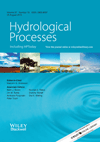Baseflow separation in a small watershed in New Brunswick, Canada, using a recursive digital filter calibrated with the conductivity mass balance method
Abstract
Baseflow separation is important for obtaining critical parameters for hydrological models. As measuring the baseflow component directly is difficult, various analytical and empirical baseflow separation methods have been developed and tested. The recursive digital filter (RDF) method is commonly used for baseflow separation due to its simplicity and low data requirement. However, parameters used in the RDF method are often determined arbitrarily, resulting in high uncertainty of the estimated baseflow rate. A more accurate method is the conductivity mass balance (CMB) method, which is established based on the differences in physical processes between baseflow and surface runoff. In this research, the output of the CMB method was used to calibrate the parameters of an RDF model, and the calibrated RDF model was used to estimate monthly, seasonal and annual baseflow rate and baseflow index for the past 19 years using streamflow discharge records. The characteristics of the baseflow hydrographs were found to be consistent with the hydrological and hydrogeological conditions of the research area. Research results indicated that the accuracy of the RDF model has been greatly enhanced after being calibrated with the CMB method so that the RDF model can provide more reliable baseflow separation results for a long-term study. Copyright © 2012 John Wiley & Sons, Ltd.




